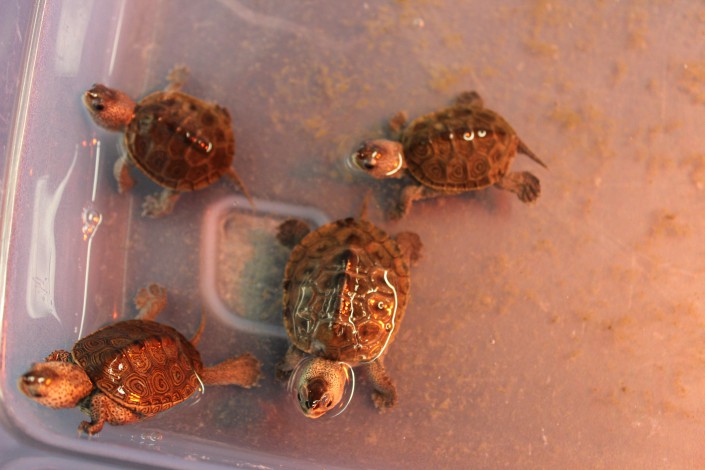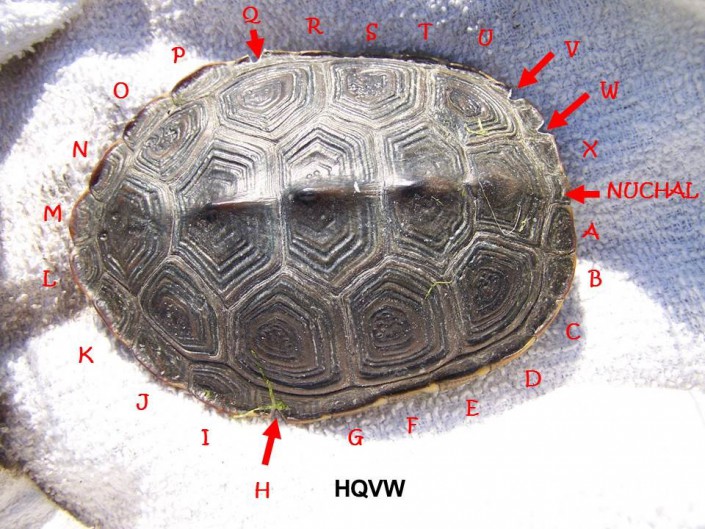Providing a Safe Haven for Diamondback Terrapins
A Closer Look at Project Terrapin, a Growing Initiative that Focuses on Diamondback Terrapin Conservation
by Kiran Sinha, 2015 Project Terrapin Field Team Member and Wildlife Conservation Intern

Diamondback Terrapins are a species native to coastal marsh areas in New Jersey. Terrapins are an interesting species, in part because they are the only native New Jersey turtle that has adapted to marsh habitats. Diamondbacks have been spotted all over the Great Bay area, increasingly so in the Manahawkin-Long Beach Island area. Although their shells are extravagant and beautiful, sometimes it is hard to notice them in the water, especially when it is dark and murky. Terrapins can travel by water and land; neither is safer than the other in the busy water and road ways of Barnegat Bay.
Diamondbacks in New Jersey have had a high mortality rate due to impact from cars and boats. In fact, only one in fifty hatchlings survive to a full-grown adult. One teacher and terrapin conservationist is trying to change that. Dr. John Wnek is a teacher at M.A.T.E.S High School in Manahawkin. Dr. Wnek is an avid terrapin conservationist and he incorporates it into his schoolwork as much as possible. For the past few years he has been rescuing terrapins in the Barnegat Bay area. Whether they are hit by a boat, a car, or trapped in a net, Dr. Wnek is there to help. He has many terrapins in his classroom, mostly those that he rescues. He introduced his love for terrapins to his students and they have joined in to help with a growing initiative, Project Terrapin.
For this project, Dr. Wnek and his students distribute over one hundred terrapin hatchlings to coastal high schools and colleges in New Jersey. These students and teachers keep their turtles in the classroom and take care of them for almost a full school year. At the end of May every year, the students and teachers from each school join at Island Beach State Park to release the hatchlings into the Barnegat Bay. When the turtles are hatched in the wild, they sometimes do not even make it to the marsh water or bay. Predators, such as seagulls, can pick them up easily when they are so small.
With the help from the schools, the terrapins are well fed and kept clean from diseases so they can finally be set free in their new homes. A very important part of maintaining the hatchlings while in the classroom is keeping track of them after they are released. Since the little turtles are too small to tag, we perform a procedure called notching. This process is like filing a human finger nail; it is quick, simple and painless. To notch a turtle shell, we use a filer to leave indents in the shell. As you can see from the pictures below, turtles have keratin plates that make up the shell, called scutes. In order to mark them accordingly to the year, we correlate each scute with the letter of the alphabet. This year we used the letters N and O, you can see the scutes that are marked on the hatchling and turtle. Once this process is complete, we finally set our little buddies go to where they can thrive and reproduce. The goal of this project is to help replenish the diamondback terrapin population, with the help of Dr. Wnek and his students, the next generation of terrapin conservationists.

Learn more:
Kiran Sinha is a summer 2015 Wildlife Conservation Intern with Conserve Wildlife Foundation of New Jersey and a 2015 field team member for Project Terrapin.

